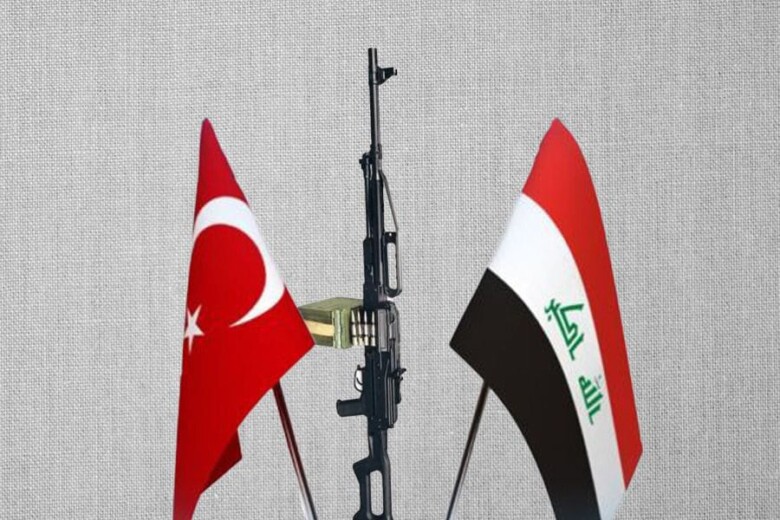On June 18, after almost a month of a siege, Iraqi PM Haydar al-‘Abadi announced the liberation of Falluja[1]. Iraqi forces, made of elite counter-terrorism units, regular army and police, entered the besieged city from the south and raised the Iraqi flag over its municipality building. At present, fighting still takes place in some areas, particularly al-Jawlan neighborhood, but the Iraqi army captures new urban areas every day and reportedly is about to complete the taking of the city within days[2]. In general, IS did not offer serious resistance: according to Iraqi sources IS suffered 377-500 casualties in Falluja and many of its men either fled or joined the convoys of displaced Fallujans, reaching shelters in Ameriyat al-Falluja.[3]
The Iraqi success in Falluja was preceded by the taking of vast areas in the west of Iraq including Ramadi (December 2015), Hit, Kubaisa (April 2016) and Rutba (May 2016). Yet , the western parts of Anbar province including the towns of Rawa, ‘Ana and al-Qaim (on the Syrian border) are still controlled by the IS and the strategic town Haditha , situated near an important dam, is still under partial IS siege.
Falluja was the first Iraqi city to fall to the IS in early 2014. Its closeness to Baghdad made it a prime target since it posed a threat to the Iraqi capital. Shii militias constantly requested giving priority to the occupation of Falluja. However, their requests were turned down before. In April 2016, following the swift taking of Rutba, speakers of the Iraqi army still declared that the following offensives will target the remaining enclaves along the Syrian and Jordanian borders.[4] This could have been a ruse. However, turning on Falluja coincided with the serious political crisis in Baghdad, which included a break of demonstrators into the “Green Zone”. Possibly, ‘Abadi changed military plans to hush the political outcry and steal the limelight from Muqtada al-Sadr. Indeed, complaints against corruption and political inability were sidelined in the media and public opinion.
‘Abadi considered the achievement a “strategic victory” and a turning point in the battle against the IS. Following the victory, Iraqi troops were sent north to start the ongoing operation to approach Mosul, Iraq’s second city and the capital of the so called “Caliphate”. The 9th armored division was sent to join the 15th infantry division. The two divisions started capturing villages to the south and south-east of Mosul. The plan is to occupy the town of Sharqat, a 100 km south of Mosul and the only remnant of IS control in the Salah al-Din province (capital:Tikrit) and from there to approach the strategic town Qiyara (60 km south of Mosul) which holds an airport to be used in the operation[5]. So far, Mosul is not within sight of the approaching Iraqi forces, nor are some other important IS strongholds in the region: Hawija, Tal’afar. It is expected that in the battle for Mosul, the Iraqi forces will be joined by the Kurdish Peshmerga who started a limited operation in Khazir, east of Mosul, local Mosuli and tribal militias and possibly also by a small Turkish military force and American commandos.
Facing all this, the IS is doing little. Other than minor, and usually unsuccessful, offensives in the areas of western Iraq or in hilly areas south of Kirkuk, aimed at detracting the Iraqi army from the main operations, there seems to be nothing they can do. The IS was trying to re-establish presence in the north of Ramadi lately, but they were easily driven out by the army[6]. An attempt to occupy the besieged Haditha in retaliation to the defeat in Falluja was another failure and this is probably beyond the ability of the organization at present. The IS suffers from serious demoralization in its ranks as the high number of escapees from battle shows. Some of the recent battles were embarrassingly easy for the Iraqi army. As many of the IS men in the beleaguered cities are local Iraqis, Iraqi officials suggested that they prefer to surrender than bring devastation on their towns.[7] Yet, for others in the IS , there is one more option of retaliation: the renewal of large scale terrorist attacks. The last months saw major IS terrorist attacks in Baghdad and in places rarely affected by IS terror in the Shii south. Iraqi security forces recently disclosed that an IS agency “Wilayat al-Janub”( The South Province) renewed its activity but this time not as a “state” agency , but as a terrorist network.[8]
In the battle for Falluja, the most important off-stage actors were the Shii militias. Despite contrary claims , the militias reluctantly accepted their auxiliary role. The Iraqi leadership insisted that the army, and other state agencies, would be solely responsible for the liberation of settled areas in the region. Thus, the militias stayed behind manning checkpoints and helping the displaced population. It is agreed that the militias will not be permitted to enter Falluja even after the complete liberation. However, in the encounters with the displaced Sunni populations the militias allegedly committed grave violations of human rights. The governor of Anbar, Sahib al-Rawi, accused the militias of the execution of 49 civilian men and the disappearance of over 600 others. Since IS men shelter among the displaced, locals escaping from IS controlled areas are separated in checkpoints and all the men are taken to interrogation. Some indeed were IS men.[9] This may be the cause of the allegations. The confirmed violations were condemned by all Shii leaders and commanders of the militias and in some cases militiamen were punished. [10]
Preparing for the Post-IS Period in Iraq
The following battles in the north will certainly be decisive for IS. While the organization is certainly preparing for the battles, it is uncertain whether its capabilities would be significantly improved. The post-IS period in Iraq, and possibly also in the Middle East and North Africa, is within sight. The IS was an over-ambitious experience in the realization of a Caliphate and the advancement of an apocalyptic vision. At its height, it attracted more than a few adventurers from over a hundred countries. It is in the nature of such religious movements to leave an ideological void after their collapse. Even if the IS would return to be a terrorist organization, it is difficult to see it recovering into a modified version of a Caliphate.
In Iraq , the post-IS period is full of concerns. So much so that commentators forget that the country survived the most serious challenge to its unity. The Iraqi army, a cross-sectarian state agency, proved capable of retrieving lost territories and improved its combat ability. To a large extent, the lessons of its defeat in June 2014 were learnt. Other military forces, primarily the various “Hashd” formations, expressed widespread , Sunni and Shii, patriotism, not often associated with this state. The military victories were Iraqi: foreign intervention was minimal and auxiliary, more American than Iranian. The “boots on the ground” were Iraqi.
Aware of the concerns, the Iraqi leadership is preparing now, before the final fall of the IS, to any eventuality. The fate of the recaptured Sunni towns serves as a barometer to what lays ahead. In most, it is too early for a return of the population. Yet, they are not controlled by Shii militias but by the local authorities and local police. The city of Tikrit, recaptured in April 2015, has seen the return of over 90% of the population and is run by its former authorities, while Shii militias were removed from the city[11]. The equilibrium in Iraq is maintained by an ethno-sectarian territorial segregation. The government assures that this segregation would be maintained. So far there is no indication that Shiis are planning to settle in Sunni areas and imperil the status quo.
Whenever the guns fall silent, Iraq would need a lot of money for the reconstruction. Most of it would be invested in the most devastated areas: Sunni areas. In a way, this would calm traditional Sunni claims of marginalization and disinvestment in their provinces. In this stage, Sunni areas would have to be completely dependent on Baghdad, as provider of funds, thus other Sunni claims for further decentralization are not expected to be aired.
Sunnis were IS’ biggest victims. The organization, often with local support, occupied most of the Sunni provinces and consequently there are about 4 million Sunnis who are internally displaced in Iraq and Kurdistan. Demographically, their numbers dwindled. This major calamity must have some impact on the Sunnis and the vision of their role in post-IS Iraq. They may become more apathetic to Iraqi politics in which they are only supporting actors. They may also initiate a process by which they adapt to their status as a minority in a state with a Shiite hegemony.
The political mayhem in Baghdad, with its social background, creates the illusion that this is yet another threat to the political system. Yet, whatever happens in Baghdad and whatever color the protest may have, it is all taking place within the majority Shii political camp. Shiis have a vested interest in the preservation of Iraq’s democratic and parliamentarian political system ,based on a universal suffrage. This system gives them political hegemony. It is therefore highly unlikely that Shiis would change the political system and establish an Iranian style “Islamic Republic” , an idea which is rejected by the great majority of Iraqi Shia.
The greatest challenge to Iraq’s unity would probably come from the Kurdish provinces. While the probability of a Kurdish unilateral declaration of independence requires a different debate, confrontations between Kurdish forces and Arab forces in disputed areas recently captured from the IS, show the tensions between the two sides, which are not likely to dissipate when the Islamic State would cease to exist.
[1] “Iraq PM Abadi Declares Victory over ISIL in Falluja”http://www.aljazeera.com/news/2016/06/iraq-pm-abadi-declares-victory-isil-fallujah-160617174259486.html
[2] Reuters Baghdad “al-Tahaluf al-dawli: al-Quwat al-‘Iraqiya Tusaytar ‘ala 50% min Falluja” http://www.almadapaper.net/ar/news/512423/%D8%A7%D9%84%D8%AA%D8%AD%D8%A7%D9%84%D9%81-%D8%A7%D9%84%D8%AF%D9%88%D9%84%D9%8A-%D8%A7%D9%84%D9%82%D9%88%D8%A7%D8%AA-%D8%A7%D9%84%D8%B9%D8%B1%D8%A7%D9%82%D9%8A%D8%A9-%D8%AA%D8%B3%D9%8A%D8%B7%D8%B1-%D8%B9%D9%84%D9%89 accessed 22.6.2016
[3] Al-Mada press “Maqtal 377 Da’ishian Baynahum 40 Qanasan fi Falluja” http://www.almadapaper.net/ar/ViewPrintedIssue.aspx?PageID=20316&IssueID=2071 accessed 20.6.2016
[4] Al-Mada Press Baghdad, “al-Jaysh Yuharir al-Rutba bil-Kamil wa-Yabda’ Ta’min al-Tariq al-Sari’ ma’a Urdun” http://www.almadapaper.net/ar/ViewPrintedIssue.aspx?PageID=19882&IssueID=2044 accessed 19.5.2016
[5] Reuters Baghdad, “al-Jaysh ‘ala bu’d 20 Kilumitran min al-Sharqat” http://www.almadapaper.net/ar/ViewPrintedIssue.aspx?PageID=20317&IssueID=2071 accesed 20.6.2016.
[6] Al Mada Baghdad, “Tashatut al-Juhd al-‘askari yu’id Da’ish ila Shimal al-Rammadi”, http://www.almadapaper.net/ar/ViewPrintedIssue.aspx?PageID=20314&IssueID=2071 acessed 20.6.2016.
[7] Wa’il Ni’ma Baghdad, “Quwa Amrikiya Tusharik fi ‘Amaliyat al-Sharqat”, http://www.almadapaper.net/ar/ViewPrintedIssue.aspx?PageID=20300&IssueID=2070 accessed 19.6.2016.
[8] http://alghadpress.com/ar/news/51238/الشرطة-الاتحادية-تعلن-اعتقال-امير-ولاية-الجنوب-لدى-داعش-غربي-بغداد
[9] See for example the arrest of Rafi’ Mishhin al-Jumaily, a senior military commander, by the “Hashd”
http://www.almadapaper.net/ar/ViewPrintedIssue.aspx?PageID=20284&IssueID=2069 . On June 20 I watched IS POWs taken, after hiding in convoys, by the Iraqi forces on Al Hurra TV.
[10] Reuters Baghdad “Wazir al-Dakhiliya: al-Intihakat fi Falluja ghair mumanhaja wa-‘Aqabna ba’d al-Mutawaritin” lhttp://www.almadapaper.net/ar/ViewPrintedIssue.aspx?PageID=20267&IssueID=2068 accessed 16.6.2016
[11] Al Mada Baghdad, “Tikrit Tahtafil bi-Murur ‘Aam ‘ala al-Tahrir wa ‘Audat 90% min Nazihiha” http://www.almadapaper.net/ar/ViewPrintedIssue.aspx?PageID=19343&IssueID=2011





